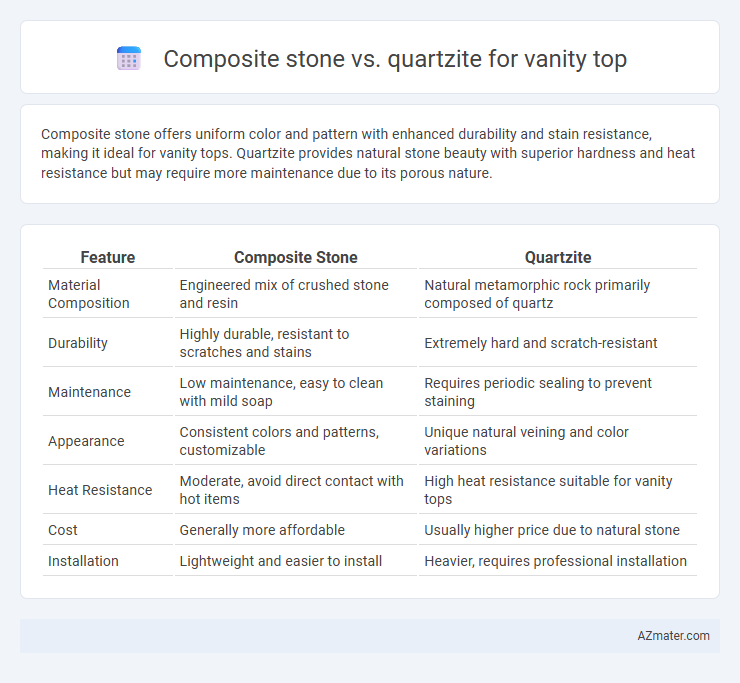Composite stone offers uniform color and pattern with enhanced durability and stain resistance, making it ideal for vanity tops. Quartzite provides natural stone beauty with superior hardness and heat resistance but may require more maintenance due to its porous nature.
Table of Comparison
| Feature | Composite Stone | Quartzite |
|---|---|---|
| Material Composition | Engineered mix of crushed stone and resin | Natural metamorphic rock primarily composed of quartz |
| Durability | Highly durable, resistant to scratches and stains | Extremely hard and scratch-resistant |
| Maintenance | Low maintenance, easy to clean with mild soap | Requires periodic sealing to prevent staining |
| Appearance | Consistent colors and patterns, customizable | Unique natural veining and color variations |
| Heat Resistance | Moderate, avoid direct contact with hot items | High heat resistance suitable for vanity tops |
| Cost | Generally more affordable | Usually higher price due to natural stone |
| Installation | Lightweight and easier to install | Heavier, requires professional installation |
Introduction to Composite Stone and Quartzite
Composite stone, composed of crushed natural stone bound with resins and pigments, offers durability and design versatility ideal for vanity tops. Quartzite, a natural metamorphic rock primarily made of quartz, boasts exceptional hardness and resistance to heat and scratching, making it a premium choice for bathroom surfaces. Both materials provide unique aesthetics and functional benefits, with composite stone allowing customizable patterns and quartzite showcasing natural stone veining.
Overview of Vanity Top Material Choices
Composite stone vanities offer a versatile and cost-effective option with non-porous surfaces resistant to stains and scratches, ideal for high-traffic bathrooms. Quartzite, a natural stone formed from sandstone, provides superior durability and a unique, elegant appearance with heat and scratch resistance, though often at a higher price point. Both materials are popular choices for vanity tops, balancing aesthetics, maintenance, and performance to suit varying bathroom design preferences.
Composition and Manufacturing Processes
Composite stone vanity tops are engineered from a blend of crushed natural stones, like marble or quartz, combined with resin binders, offering enhanced durability and uniformity. Quartzite vanity tops are fabricated from natural metamorphic rock primarily composed of quartz grains fused through intense heat and pressure, resulting in a highly dense and heat-resistant surface. The manufacturing process for composite stone involves molding and curing the mixture under controlled conditions, while quartzite slabs are quarried, cut, and polished to reveal their natural veining and texture.
Aesthetic and Color Options
Composite stone vanity tops offer a wide range of vibrant colors and customizable patterns, making them ideal for matching diverse bathroom aesthetics. Quartzite provides a natural stone appearance with unique veining and a more limited, earthy color palette dominated by whites, grays, and subtle browns. The engineered nature of composite stone allows for greater consistency and versatility in design compared to the organic variations found in quartzite.
Durability and Resistance to Damage
Composite stone vanity tops offer excellent durability, combining crushed natural stone with resins that create a non-porous and scratch-resistant surface ideal for daily bathroom use. Quartzite, composed of natural quartz crystals, provides superior hardness and resistance to heat and abrasion, making it highly resistant to chipping and staining compared to other natural stones. Both materials excel in durability, but quartzite's natural composition typically offers enhanced resistance to physical damage and long-term wear.
Maintenance and Cleaning Requirements
Composite stone vanity tops require minimal maintenance, as they resist stains, scratches, and do not need sealing, making cleaning with mild soap and water sufficient. Quartzite, a natural stone, demands periodic sealing to prevent staining and requires non-abrasive cleaners to maintain its polished surface. Both materials offer durability, but composite stone provides easier upkeep and long-term stain resistance compared to quartzite's more intensive maintenance routine.
Cost Comparison: Composite Stone vs Quartzite
Composite stone vanity tops typically cost between $40 to $100 per square foot, offering an affordable alternative with versatile design options. Quartzite, a natural stone, generally ranges from $70 to $150 per square foot, reflecting its higher durability and unique veining patterns. The price difference hinges on material origin and processing, making composite stone a budget-friendly choice while quartzite provides premium aesthetics and longevity.
Environmental Impact and Sustainability
Composite stone vanity tops often contain recycled materials and resins, making them a more sustainable choice due to lower quarrying impact and reduced waste. Quartzite, a natural metamorphic rock, requires extensive mining and processing that results in higher energy consumption and habitat disruption. Choosing composite stone can significantly reduce the environmental footprint of bathroom renovations by promoting resource efficiency and minimizing carbon emissions.
Pros and Cons of Composite Stone Vanity Tops
Composite stone vanity tops offer a versatile and cost-effective alternative to natural quartzite with advantages such as non-porous surfaces that resist stains and require minimal maintenance. These engineered materials provide a wider range of colors and patterns, along with enhanced durability against scratches and impact compared to quartzite. However, composite stone may lack the natural uniqueness and heat resistance of quartzite, which can be a drawback for some homeowners seeking authentic stone aesthetics and performance.
Pros and Cons of Quartzite Vanity Tops
Quartzite vanity tops offer exceptional hardness and natural beauty, providing high resistance to scratches and heat, which makes them a durable choice for bathroom surfaces. However, their porosity requires regular sealing to prevent staining and water damage, and they tend to be more expensive than composite stone options. Unlike composite stone, quartzite features unique veining and colors, adding a luxurious touch but demanding careful maintenance to preserve its appearance.

Infographic: Composite stone vs Quartzite for Vanity Top
 azmater.com
azmater.com